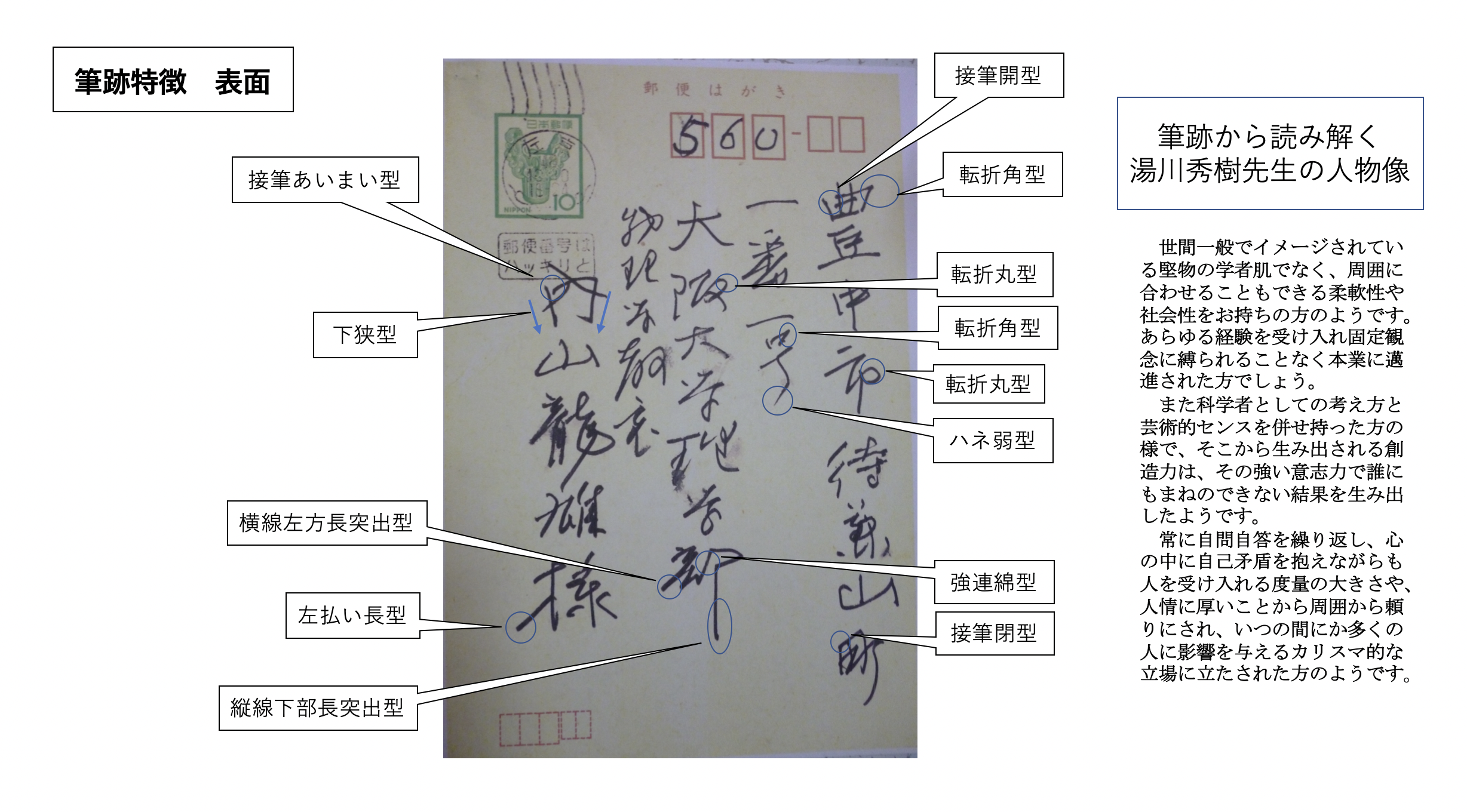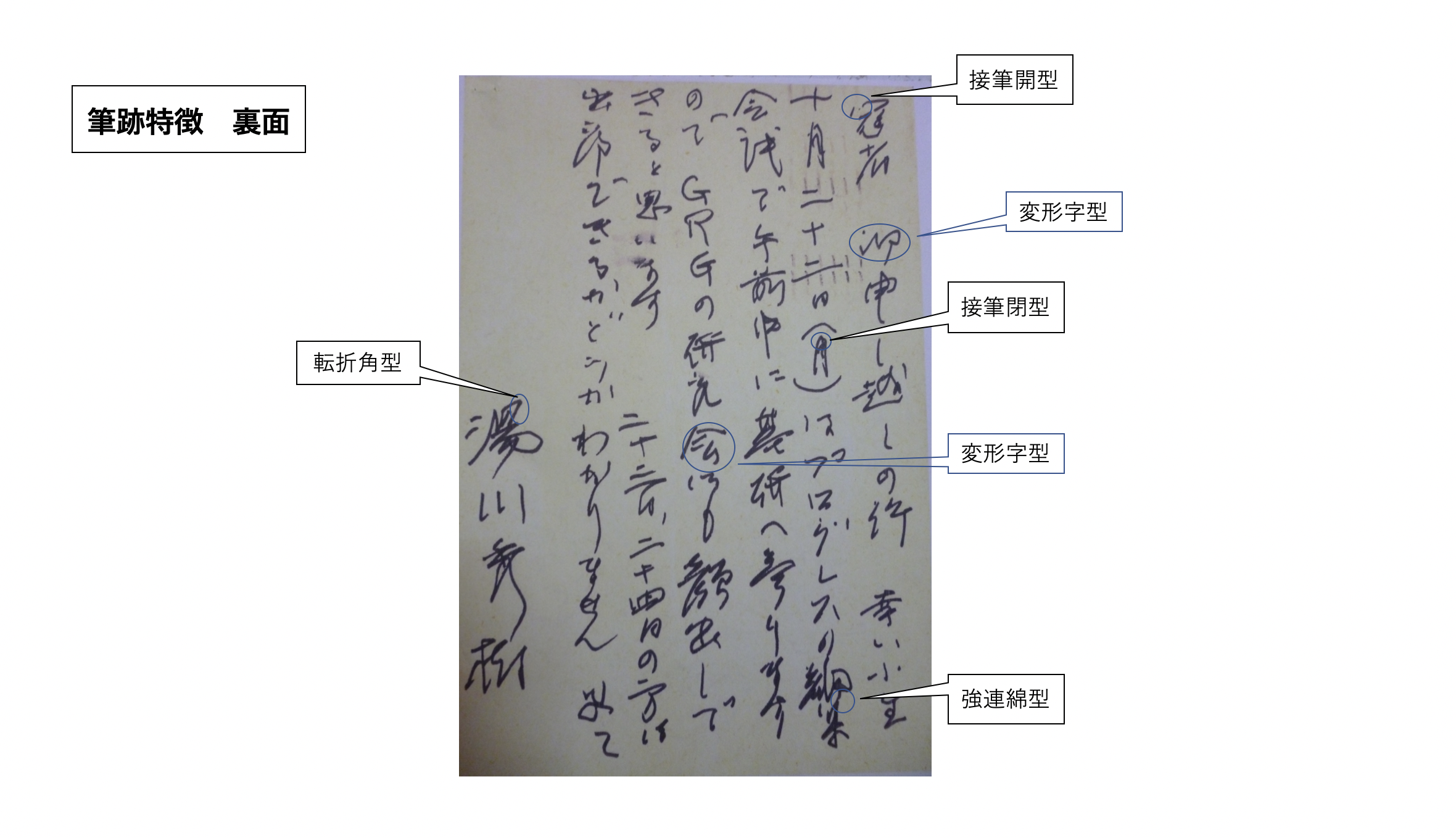Hideki Yukawa’s handwriting and what it tells about him
What kind of a person was Hideki Yukawa? Yukawa Memorial, The University of Osaka had an opportunity to have Dr. Yukawa’s handwriting analyzed to see what his handwriting tells us about him.
The following introduces Hideki Yukawa’s personality inferred from his handwriting, courtesy of Mr. Asakura, the president of Asakura Business Service, a handwriting analyzing company.
What Yukawa’s handwriting on the postcard tells us about him (commentary)
The handwriting analysis examines the characteristics of the general arrangement of written characters on paper, such as the positions and sizes of characters, as well as the characteristics of each character in order to comprehensively judge the writer’s personality and characteristics. If you take a look at the entire front side of the postcard, you will first notice that there is no sender’s name or address and the addressee’s name extends to the area where the sender’s name and address are usually written. There is no sender’s name or address on the back side of the postcard, either.
Generally speaking, if the sender and the recipient are close friends for example, the sender’s address is sometimes omitted since the recipient knows who the sender is. Even so, writing the addressee’s name and address over the entire front side of the postcard suggests the writer’s free and unrestricted attitude to do things without being governed or restricted by formalities or etiquette rules. While the address and name are written in the fluent semi-cursive/running writing style, some characters such as “豊” and “内” are written in block letters. It seems that the writer wrote them without feeling restricted by font types. Many writers in the Meiji period wrote the addressees’ names and addresses in large characters over the entire postcard surfaces. For example, Takuboku Ishikawa, a famous poet, used to write that way. Although people tend to write the name and address on the front side of postcard in relatively large characters, people who write them in large characters are regarded to be free-wheeling, innocent people, according to the handwriting analysis.
 Next, let’s look at each character to find out unique characteristics.
Next, let’s look at each character to find out unique characteristics.
In handwriting analysis, the line contacting sections and the bends of lines in each character are especially important. For example, when we learn the kanji character, “口,” for the first time, we are taught to ensure that all lines be in contact with each other and that each turn of line has a unmistakable corner. However, as we get older and become somewhat flexible and assimilative, we acknowledge various styles of handwriting and do not feel strange about lines not contacting properly in kanji characters. I’m sure, however, that there are some people who feel awkward to see completely open spaces at places where the lines should meet. Depending on the size of the gap between lines, the style can be categorized as one of the following: “closed space between lines,” “open space between lines” and “ambiguous line contact.” Similarly, even though people get older and become used to seeing many “rounded” characters, some people continue to change the direction of line with a clearly identifiable corner exactly as they learned in school, while some people take an easy way of writing by rounding corners although the rules say not to. The handwriting analysis for personality assessment is similar to guessing the personality of a person by examining how he or she crosses a pedestrian crosswalk.
In the handwriting analysis, the way the lines contact each other tells the writer’s flexibility of thinking, and the sharpness of line bends indicates how the person puts his/her thoughts into action. In the case of Dr. Yukawa, various styles are mixed for both line contacts and sharpness of line bends. This suggests that he was flexible in both thinking and acting. This type of person can respond flexibly according to situations when interacting with other people.
There is a point to note, however. No matter how freely the kanji characters mentioned above are written, their “forms” as kanji characters must not be destroyed completely. Some handwriting styles are categorized as “beyond-comprehension type,” which are illegible to other people. This type of handwriting is often seen among the writers who abbreviate or deform characters in his/her own original ways. For example, Nobunaga Oda, a noted warlord in the Sengoku period, used to write that way. These people tend to steamroll forward. In the case of Dr. Yukawa, however, I understand that he was flexible but not a type of a person who insisted on doing things his way without paying heed to the reactions of people around him.

Next, let’s examine the characteristics of the stoke lines in each character. Dr. Yukawa’s written characters are not a simple “script font,” but the line moving from one character to the next has the same thickness as others. This “enhanced script font” can be seen in the character “部” on the front side of the postcard and “編集” on the back side. This method of handwriting requires the writer to continue drawing the powerful-looking lines, and this type of characters can be seen in the handwriting of people with great concentration power and unwavering confidence. This handwriting style can also be found in the handwriting of Nobunaga Oda, Kuranosuke Oishi and Musashi Miyamoto.
The long vertical line extending downward in the character “部” on the front side of the postcard suggests that the writer was a tenacious person who strove relentlessly to produce good results. This style can be observed in the handwriting of Ieyasu Tokugawa. Let’s take a look at the upward stroke lines next. The character “号” written on the front side of the postcard has a weak upward stroke line, while the character “内” contains a strong upward stroke line. The weak upward stroke line indicates that the writer was capable of quickly and smartly completing task after task and that the writer had a straightforward personality and was quick to move on to the next challenge, according to the extensive records of analyses. On the other hand, the strong upward stroke line indicates that the writer was a tenacious and responsible person and had strong will to continue trying until satisfied. I think Dr. Yukawa had conflicting personalities and always felt self-contradiction within himself. Long left stroke lines such as the one in the character “様” on the front side of the postcard can be found in the handwriting of people who emanate gorgeous, star-like ambiences by just being present at the place. Long horizontal lines extending toward left similar to the one in the character “部” on the front side of the postcard can be found in the handwriting of Taishi Shotoku, Yukimura Sanada and Toshimichi Okubo. According to the handwriting analysis, those lines indicate that the writers were quick-witted persons and had talents and good ambiences around them to draw the attention of others.
Let’s look at the overall shapes of characters. The character “内” written on the front side of the post card becomes gradually narrower toward the bottom. This handwriting style means instability and artistic sense, according to the handwriting analysis. A person who writes this way is said to have an original and unique idea forming style and come up with novel ideas. People who deform characters in their own styles and write barely legible characters are said to have a similar personality.
Graphologist certified by Japan Graphologist Association
Hiroyuki Asakura, President of Asakura Business Service




